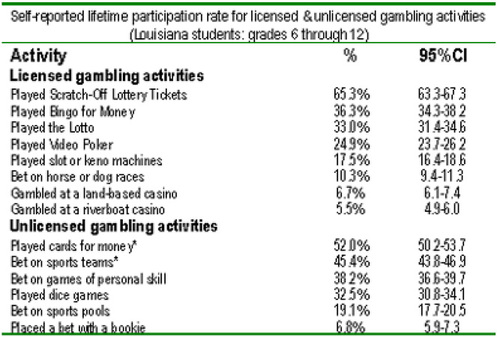Louisiana is one of many states in America to participate in the expansion of legalized gambling over the past twenty years. As a result, gaming is accessible to the masses. However, gambling is illicit for adolescents. Consequently, it is interesting to examine the "games" of chance that Louisiana adolescents play. Westphal, Rush, Stevens and Johnson (2000) did exactly this when they investigated adolescent gambling. During the 1996-1997 school year, Westphal et al. conducted research with registered Louisiana public and private school students (n=12,066) in grades six through twelve to determine the pattern of gambling activities among this randomly selected cohort.
Study participants completed the South Oaks Gambling Screen-Revised for Adolescents (SOGS-RA). The investigators used the following SOGS-RA scoring algorithm: 0-1 indicates no problem with gambling (Level 1); scores of 2 or 3 indicate young people at-potential for problem gambling (Level 2); and, finally, a score of 4 or higher indicates students at-potential for pathological gambling behavior (Level 3).
SOGS-RA scores showed that the majority of the adolescent sample population (70.1%) were Level 1 gamblers. Level 2 gamblers comprised 10.1% of the student sample, and 5.8% of these young people were Level 3 gamblers. Fourteen percent of those sampled had no previous gambling experience. In addition, while a majority of the sampled students engaged in a variety of licensed and unlicensed gambling activities, this same majority reported that they gambled infrequently. Only a minority of students gambled frequently (Westphal, et al., 2000). More specifically, monthly-or-less participation in the most popular gambling activities ranged from 83.5% to 95%, while very frequent gambling participation ranged from 16.5% to 5% for this same group of popular gambling activities (Westphal, et al., 2000).
The following table presents lifetime participation rates for these frequently played games among the Louisiana student sample, as well as participation rates for other popular licensed and unlicensed gaming activities.
Gaming participation rates for Level 1 adolescent gamblers were not significantly correlated with adverse consequences reported by a minority of those sampled. These consequences included arguments over gambling, skipping school to gamble, and stealing to gamble. Combined with infrequent gambling participation, these results suggest that gambling may be normative for this age group (Westphal et al., 2000).
High participation rates, regardless of frequency, indicate that some form of gambling education and/or prevention is necessary for this age group in order to inhibit potential problem and pathological gambling in later years. Westphal et al. suggest implementing an avoidance model that informs students about both the risks and symptoms of problem and pathological gambling (Westpahl, et al., 2000); however, it might be equally valuable to address gambling as a precursor to other self-destructive risk behaviors like tobacco, alcohol, or drug abuse.
More research is needed to address the significance of adolescent gambling and its potential effect on adolescent gamblers into adulthood. Moreover, investigators must examine the relationship between gambling disorders and other substance abuse problems more thoroughly to evaluate the influence of adolescent gambling on other adolescent risk behaviors including the use of tobacco, drugs, and alcohol. Finally, as Ladouceur and his colleagues recently demonstrated, respondents might not have accurately completed the SOGS, since young people might have misinterpreted the meaning of SOGS items (Lacouceur et al., 2000). As such, SOGS-RA scores of Levels 1, 2, and 3 gambling may not be an accurate measure of at-potential gambling among the sample population.
References
Lacouceur, R., Bouchard, C., Rheaume, N., Jacques, C., Ferland, F., Leblond, J., & Walker,
M. (2000). Is the SOGS an accurate measure of pathological gambling among children, adolescents and adults? Journal of Gambling Studies, 16(1), 1-24.
Westphal, J.R., Rush, J.A., Stevens, L, & Johnson, L.J. (2000). Gambling behavior of Louisiana students in grades 6 through 12. Psychiatric Services, 51(1), 96-99.
Shaffer, H. J., Hall, M. N., Walsh, J. S., & Vander Bilt, J. (1995). The psychosocial consequences of gambling. In R. Tannenwald (Ed.), Casino Development: How Would Casinos Affect New England’s Economy? (pp. 130-141). Boston: Federal Reserve Bank of Boston.





